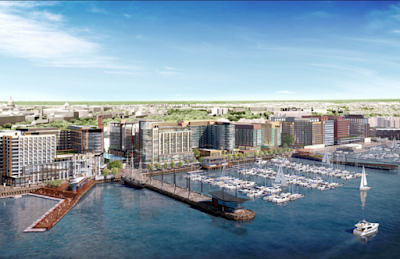 Last night, the massive redevelopment of Southwest’s waterfront inched a couple of notches closer to reality. DC’s Zoning Commission held a proposed action hearing for the project’s first phase, approving information that had been newly submitted and asking no follow-up questions.
Last night, the massive redevelopment of Southwest’s waterfront inched a couple of notches closer to reality. DC’s Zoning Commission held a proposed action hearing for the project’s first phase, approving information that had been newly submitted and asking no follow-up questions. That sets up the $1.5 billion project, technically titled The Wharf and comprising 3.2 million square feet in total, for a final action hearing next month, which at this point should largely be a formality. After that, developers PN Hoffman and Madison Marquette will be in the clear to begin applying for permits and seeking construction financing.
This was a very short, perfunctory hearing. On November 14, the commission approved three out of the development’s four parcels for the second stage of the PUD process, which examines public benefits, architecture and design (the first stage, which looks at height, density and zoning issues, was approved late last year).
But the members had questions regarding the last parcel; most prominently, they worried that the residential building on 6th Street lacked direct entrances and looked unusually stark. In response, the developers changed the facades, pushing the residential building back five feet in order to allow for direct entry by residents.
“This is a significant improvement,” said Commissioner May, who’d expressed concern at last month’s meeting. “I’m pleased with this result.” The commissioners had no other questions.
That means all four parcels, each of which contains one or two buildings, have been approved—“knock on wood,” said Shawn Seaman, a PN Hoffman principal and project director for the development. The team has a lot to accomplish in the next few months, and the estimated start date has been pushed back a few months from earlier predictions. “We’re looking at a groundbreaking early in the second quarter of 2013,” said Seaman.
This first phase of development will eventually bring 1.5 million square feet of retail, residential, hotel and office space to the area, along with four piers and several open spaces, including a three‐acre waterfront park. The Hoffman-Madison team sees the project as eventually matching internationally-known destinations like San Francisco's Embarcadero and Pike Place Market in Seattle.
Washington, D.C., real estate development news



















 The $2 billion, 2.5 million-square-foot project, dubbed “The Wharf,” takes its cues from
The $2 billion, 2.5 million-square-foot project, dubbed “The Wharf,” takes its cues from 


























